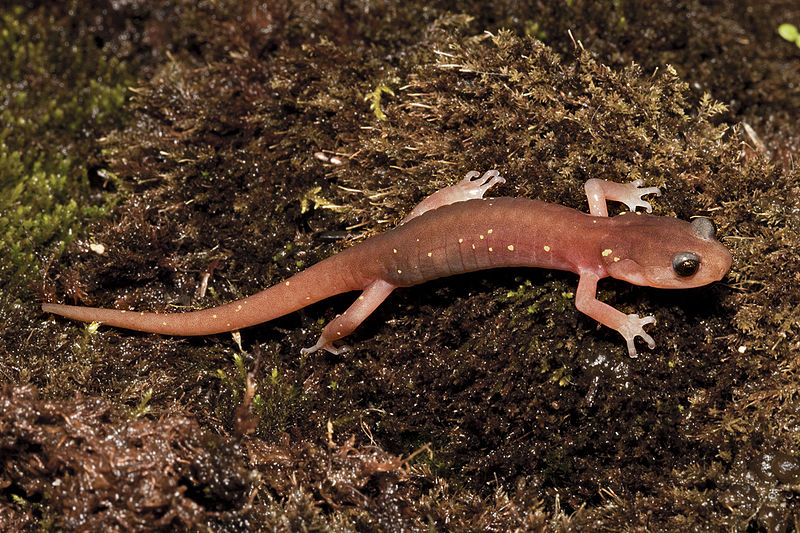Trouble for America’s Amphibians
On average, the rate of loss of populations of all amphibians in the USA is 3.7% per year. The scientists believe that if this rate does not change, these species will disappear from half of the habitats that they currently occupy in around 20 years.
 Image: By Bill Bouton [CC-BY-SA-2.0 (http://creativecommons.org/licenses/by-sa/2.0)], via Wikimedia Commons
Image: By Bill Bouton [CC-BY-SA-2.0 (http://creativecommons.org/licenses/by-sa/2.0)], via Wikimedia Commons The first ever estimate of the rate of decline of frogs, toads and salamanders in the United States has revealed that it is alarming fast. They are disappearing across the country, regardless of habitat, and even those that were presumed to be stable and widespread are in danger.
The study, by scientists from the US Geological Survey, was published in the journal PLoS ONE. It concluded that amphibian declines are much more severe and more widespread than has previously been realised. On average, the rate of loss of populations of all amphibians in the USA is 3.7% per year. The scientists believe that if this rate does not change, these species will disappear from half of the habitats that they currently occupy in around 20 years.
The most threatened species, those featuring on the IUCN Red List of threatened species, disappeared from their habitats at a rate of 11.6% each year. If this rate remains unchanged, they will disappear from half of the habitats they currently occupy in about 6 years. Most surprisingly, species that were thought to be stable and capable of sustaining their populations, those listed as being of Least Concern by the IUCN, are also decreasing in number, with an annual decline of 2.7% per year. The authors of the study called this particular finding “alarming” as these are species which had seemed to be unaffected by global amphibian declines, and this means that the IUCN threat status is under-estimated for some species.
Data from 34 sites and 48 species, over a time period of 9 years (2002-2011), was used for this study to examine how fast clusters of amphibians are disappearing from ponds, lakes and other habitat features across the landscape. The scientists did not evaluate the cause of declines, but these are likely to include climate change, disease, contaminants, land use change and drought. Significant declines are occurring even in protected areas such as national parks and wildlife refuges, where land is managed for conservation. According to the authors of the study, this shows that threats to amphibians “transcend landscapes” and warn that “this is a global phenomenon with implications for managers of all kinds of landscapes.”
Amphibians across the world are experiencing the worst declines among vertebrates, although all major animal groups associated with freshwater are faring badly. This study will provide a valuable point of reference for tracking the current problems experienced by amphibians in the United States, and monitoring future changes.





One Comment
Well, I think the fact is even more dramatic than this! I have done my Masters thesis (2011-Australia) on Amphibian extinction crisis and reliability of ARTs as a potential response to this ongoing disaster……
According to the reports based on research into global status of amphibians, catastrophic global loss of amphibians and mass localized extinctions started to occur nearly 50-60 years ago. In fact, these population crashes seem to have worsened during the last two decades, to the point that nowadays many amphibian species are considered as critically endangered species . According to IUCN’s global amphibian assessment (2009) and subsequent updates, 1991 species of amphibians are listed as globally threatened species facing severe population crashes (489 critically endangered species, 787 endangered species and 715 vulnerable species) which constitute nearly %32 of the global amphibian population. Meanwhile, another 2469 species are suffering or starting to suffer from unexpected population declines, representing %43 of the total amphibian population in the world . All these figures indicate that current amphibian population declines and crashes are far more dramatic than standard extinction trend under normal conditions of demographic variations, forecasting that an alarming number of extinctions may occur in the near future . Furthermore, compared to the extinction rate of other vertebrates (mammals, birds and even reptiles), current amphibian extinction rates are much more severe and more tragic, even comparable to the extinction rate of dinosaurs that occurred 65-230 million years ago . Although amphibian population declines have been observed all around the world, according to IUCN’s global amphibian assessment amphibian population crashes and regional concentration of threatened amphibian species are particularly intense in Central and South America, Australia, the Philippines and the Caribbean (Now you can add the United States to the list!!!). In other words all these regions together contain more than %50 of currently known threatened amphibian species . For instance, three Latin American countries; Colombia, Mexico and Ecuador are listed on top of the countries with the largest numbers of threatened species. They, in combination contain 596 threatened species, representing almost one third of all threatened species (214 threatened species in Colombia, 211 in Mexico and 171 in Ecuador.
Just to conclude the statistics reveal that currently (during the last 3 decades) amphibians are disappearing at a rate nearly 211 times greater than the mean background amphibian extinction rate. Moreover, taking threatened species into account (especially critically endangered species) in the calculations of current amphibian extinction rates, this remarkable figure expands to an unprecedented number of 25039 to 45474……!!!!!!!!!!!!!!!